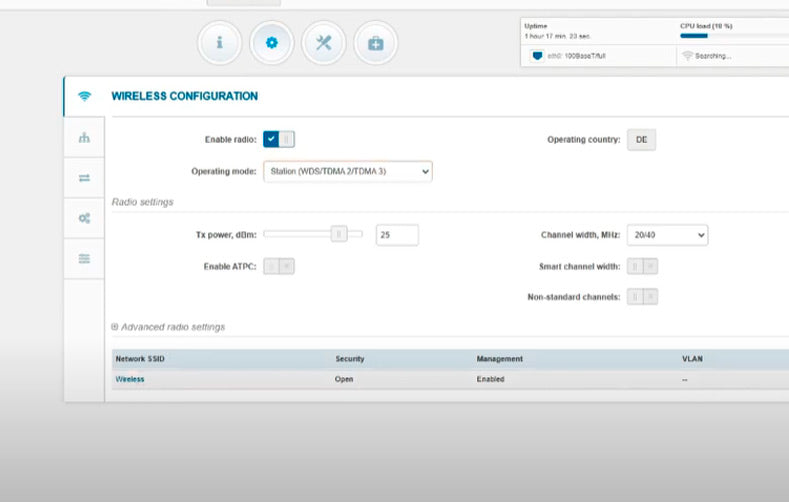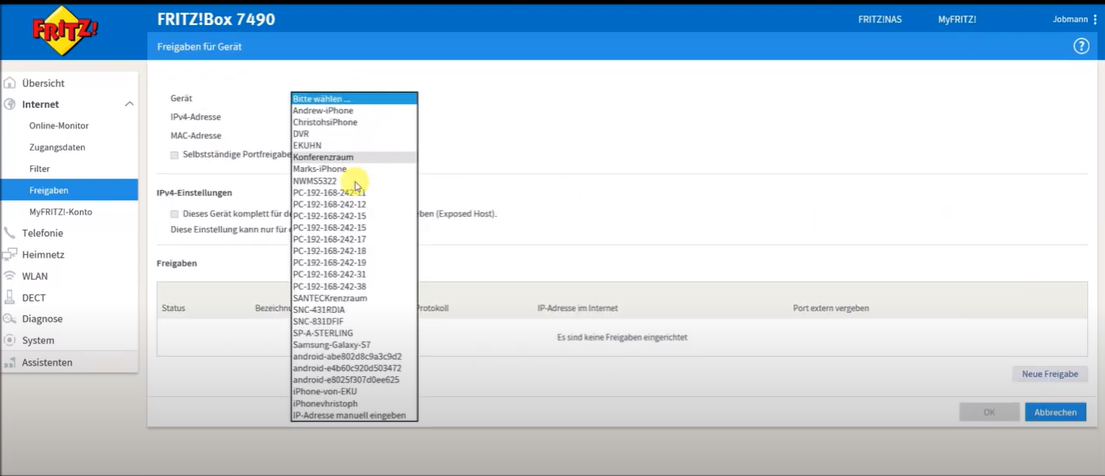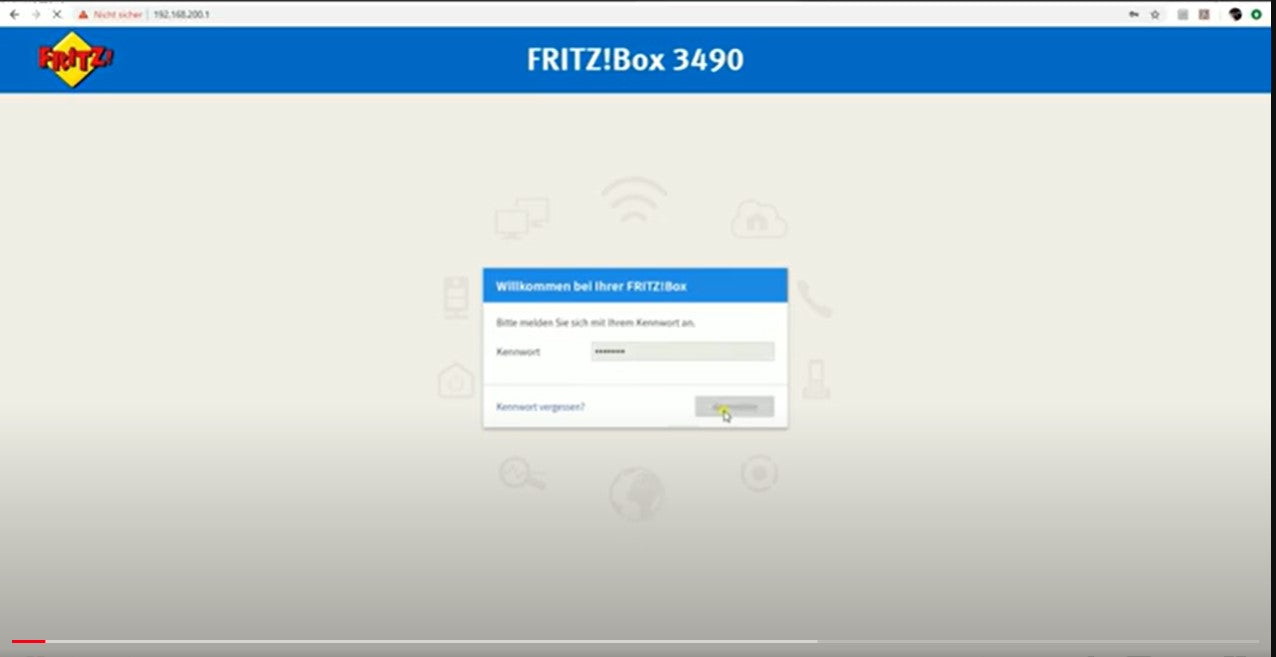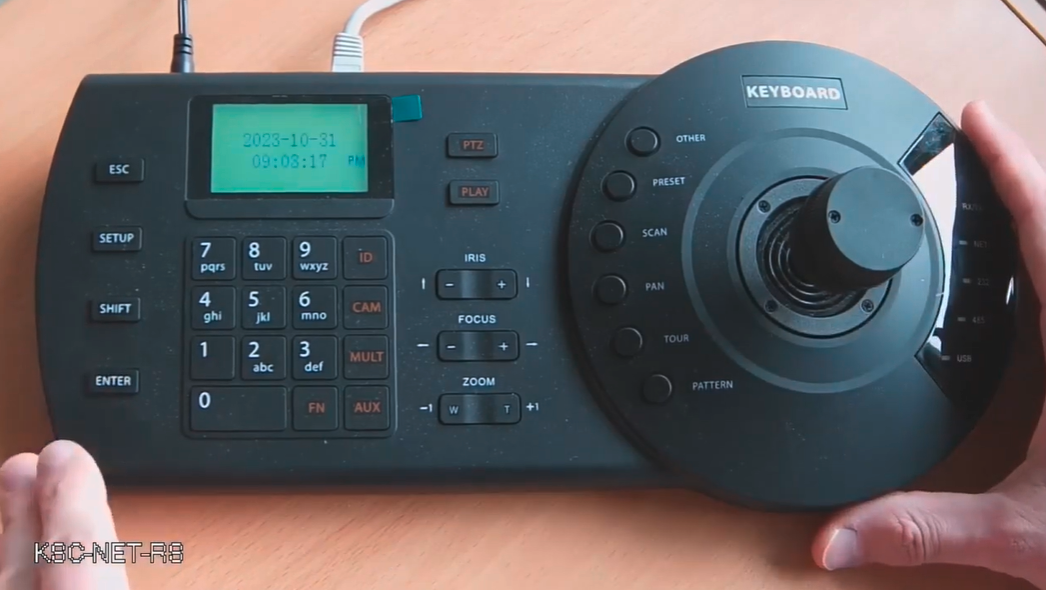FAQ's on things to know
Things to know



Port forwarding using the example of a Fritz box

Saving via FTP on the Fritzbox


ABF (Autobackfocus)
Automatic focusing by shifting the sensor position
AC (Alternating Current)
Alternating current
AES (Auto Electronic Shutter)
Electronically controlled exposure
AF (Autofocus)
Automatic focusing
AGC (Auto Gain Control)
Automatic gain control
AI (Artificial Intelligence)
Artificial intelligence (AI) describes the highly efficient evaluation of data with the help of artificial intelligence
AI (Auto Iris)
Automatic iris
ASP (aspherical)
Aspherical optics refers to an optical system consisting of lenses or mirrors that contains at least one surface (refracting lens surface or mirror surface) that deviates from the spherical shape. An aspherical (= non-spherical) surface offers better possibilities for correcting imaging errors, as the surface can be freely shaped to a large extent.
ATW (Auto Tracking White Balance)
Semi-automatic white balance, which generally regulates the outdoor area between 1800°K and 10500°K and the indoor area between 3000°K and 10500°K.
AWB (Auto White Balance)
Automatic white balance. Here the camera searches for the brightest area in the image area and adjusts it to white.
AWC (Auto White Balance Control)
Automatic white balance (controlled). Here I give the camera a white value as a reference (e.g. a white sheet of paper) and let this value act as the white value.
BAS (Bild Austast Synchron Signal)
Common term in Germany for a monochrome television signal, consisting of the actual picture content as well as the blanking and synchronization signal.
BLC (Back Light Compensation)
Back light compensation.
BPS (Bits per second)
Unit of measurement for data transmission rate (bits per second).
C/CS mount (C/CS lens mount)
Designation for an industry standard for lens mounts; today's cameras are usually equipped with a CS mount, which can also accommodate C-mount lenses using an adapter ring. The flange focal distance for C-mount is 17.526mm and for CS-mount 12.526mm.
CCD sensor (Charge coupled Device Sensor)
Image recording sensor used in analog cameras and read out line by line.
CCIR (Comité Consultatif International des Radiocommunications)
Black/white television standard - see BAS
CCTV (Closed Circuit TeleVision)
Video surveillance systems
cd (candela)
1 candela is the photometric Si base unit of luminous intensity. 1 candle has a luminous intensity of 1 candela.
CD (Compact Disc)
Digital storage medium with a maximum capacity of 700MB.
CIF (resolution abbreviation 360 x 288)
A video image with both half vertical and horizontal resolution.
CMOS (Complementary Metal Oxide Semiconductor)
Digital image recording sensor that can evaluate each individual pixel, but is less sensitive to light than a CCD sensor.
CMS (Content Management System)
Software for the evaluation of several identical image storage devices with different locations. Graphical elements with links (emaps) are usually integrated.
CVBS (Color Video Blanking Signal)
see FBAS
D1 (resolution abbreviation 720 x 576)
Standard video resolution for analog image transmission.
D/N (Day/Night)
If cameras are designated with this abbreviation, the video images are output in color during the day and in black and white at night.
DC (Direct Current)
Direct current
DDNS (Dynamic Domain Name System)
Devices that can process this protocol are able to use a provider (e.g. DynDns) to convert your IP address into a name that remains unchanged, unlike an IP address that is assigned by your provider and changes every 24 hours.
DHCP (Dynamic Host Configuration Protocol)
Devices that support this protocol are automatically assigned their IP address by a server (or router) in the local network.
DI (Digital In)
An input on the device for triggering an event (alarm, message, recording, etc.).
DIS (Digital Image Stabilizer)
Cameras that have an integrated DIS make the image appear stable on the screen, even if they are exposed to slight vibrations.
DNR (Dynamic Noise Reduction)
Dynamic Noise Reduction reduces the image noise of a video image.
DNS (Domain Name System)
The DNS converts all names entered in the address line of the browser into the corresponding IP address to avoid the laborious entry of IP addresses on the Internet. Instead of entering e.g. 183.112.231.87,
the name www.Beispiel.de is sufficient. There are so-called DNS servers on the Internet specifically for this purpose.
DO (Digital Out)
An output on the device that can switch external contacts on/off.
DSL (Digital Subscriber Line)
DSL is the current transmission standard with which "the last mile" to the connection in your house is realized.
With the existing 2 copper wires, which go from the exchange of your provider to the telephone connection socket in the house, transmission rates (download) of up to 50 Mbit are possible.
DSP (Digital Signal Processor)
The chip that converts all the data coming from the image sensor into a video image (e.g. current Winner IV chip).
DSS (Digital Slow Shutter)
Cameras equipped with a DSS allow longer exposure times, so the image sensors see the scene for longer and are therefore exposed for longer, making the displayed images brighter.
DuPo (Dual Power)
Devices that support DuPo can be operated with both DC and AC voltage.
DVD (Digital Versatile Disc)
Digital storage medium with a maximum storage density of 9.4 GB in double layer format.
DVR (Digital Video Recorder)
All of today's recording devices store video data digitally on a hard disk or fixed memory. This means that there is no longer any loss of quality as with the old VHS tape recorders.
EMAP (electronic map)
Visual representation of the position of cameras (or alarm inputs/outputs) in a video surveillance system (e.g. on a floor plan of a building). Symbols of the existing cameras can be integrated into this image, which usually display the respective camera image with a click
.
FBAS (Farb Bild Austast Synchron Signal)
Analog video image transmission technology, also known colloquially as color television.
FLC (Flickerfree)
A function integrated into cameras that reduces image flickering.
FPS (frames per second)
Frames per second. Analog video transmission usually outputs 25 fps. With IP cameras that work in the megapixel range, the frame rate is usually lower. The human eye recognizes movements as smooth from a frame rate of 25 fps.
FREEZE (freeze)
Still image. With this function, the current single image can be loaded into a memory, e.g. to be able to view special details more closely.
FTP (File Transfer Protocol)
Standardized protocol for transferring files in the WAN or LAN
GSM (Global System for Mobile Communications)
Standard for fully digital mobile networks, which is mainly used for telephony, but also for circuit-switched and packet-switched data transmission as well as text messages (SMS).
GUI (Graphical User Interface)
Graphical user interface that simplifies operation of the processor-based device. There is no need to enter commands via a command line (e.g. a PC with Microsoft Windows).
H.264 (video compression standard) The latest video compression standard (also MPEG-4 AVC), which only achieves around a third of the data volume compared to MPEG-2, for example, with comparable quality. However, the computing effort is 2-3 times higher. This standard is also designed for high-resolution image data (e.g. HDTV).
HD (High Definition)
Video data with a higher resolution than the analog standard of 720 x 576 pixels is usually referred to as high-definition. The new HDTV displays 1920 x 1080 pixels.
HDD (Hard Disk Drive)
Hard disk. Today's hard disks can store up to 2 TB of data. The size of hard disks has not changed in recent years, but data density has increased rapidly.
HLC (High Light Compensation)
A function integrated into cameras that masks very bright areas in night mode (e.g. the headlights of a vehicle) to make special details (e.g. the license plate) more visible.
HSCSD (High Speed Circuit Switched Data)
Extension of the GSM mobile radio standard CSD to achieve faster data transmission. By bundling several data channels, data transmission rates of up to around 115.2 kbit/s (= 8 × 14.4 kbit/s) can theoretically be achieved.
HTTP (Hypertext Transfer Protocol)
The Hypertext Transfer Protocol is a protocol for transferring data over a network. It is mainly used to load web pages from the World Wide Web (WWW) into a web browser.
HTTPS (Hypertext Transfer Protocol Secure)
The Hypertext Transfer Protocol is a tap-proof protocol for transferring data over a network. It is mainly used to load web pages from the World Wide Web (WWW) into a web browser. The best-known application is home banking, for example.
ID (Identification)
In a network of several identical devices, IDs are assigned to enable unique identification and possibly also control (e.g. several high-speed domes in a serial cable structure).
IDE (Integrated Drive Electronics)
Physical interface for addressing hard disks, which has, however, been replaced by the new SATA and SATA-II standard. The transfer rates today are around 300Mbyte/s.
IMAP (Internet Message Access Protocol)
The IMAP application protocol allows access to and management of e-mails received in a mailbox on a mail server.
IP (Internet Protocol)
The Internet Protocol (IP) is a network protocol widely used in computer networks and forms the basis of the Internet.
IR (Infrared)
A range of light that is not visible to the human eye. For CCTV applications, IR spotlights with wavelengths between 880 and 950 nm (nm=nanometer) are usually used.
IR-cut (Infrared-cut)
Filter that blocks the infrared part of the light. Today's T/N cameras are equipped with a mechanical IR-cut filter that moves away at night to allow the infrared light component to pass through.
IR-LED (Infrared-Light Emitting Diode)
IR-LEDs are used for the "invisible" illumination of objects. Most IR spotlights are equipped with IR LEDs.
ISDN (Integrated Services Digital Network)
Integrated Services Digital Network (ISDN) is an international standard for a digital telecommunications network and can be translated as a service-integrating digital network. Various services such as telex, teletex, Datex-L (circuit-switched data transmission), Datex-P (packet-switched data transmission) and telephony are transmitted and switched via this network.
JPEG (Joint Photographic Experts Group)
JPEG is the common name for the ISO/IEC 10918-1 or CCITT Recommendation T.81 standard introduced in 1992, which describes various methods of image compression. The term "JPEG" goes back to the Joint Photographic Experts Group, which developed the JPEG standard.
LAN (Local Area Network)
Local computer network, usually covering one or more rooms, but rarely more than one property.
LCD (Liquid Crystal Display)
A liquid crystal display (LCD ) is a screen or display whose function is based on the fact that liquid crystals influence the polarization direction of light when a certain level of electrical voltage is applied. (see also TFT)
Mbps (Megabit per second)
Unit for data rate in computer networks.
MJPEG (Motion - Joint Photographic Experts Group)
Motion JPEG (MJPEG) is a video codec in which each individual frame is compressed separately as a JPEG image.
MOD (Minimum Object Distance)
The Minimum Object Distance (MOD) is a term used in photography. It refers to the shortest distance between the foremost lens and the subject that can still be brought into focus with the focus ring (set to "close").
MPEG (Moving Picture Experts Group)
The Moving Picture Experts Group (MPEG ) is a group of experts working on the standardization of video compression and related areas such as audio data compression or container formats. Colloquially, "MPEG" is not usually used to refer to the expert group, but to a specific MPEG standard. Today's recording devices usually store the video data on the hard disk in the MPEG-4 standard.
MPEG2 (Moving Picture Experts Group Standard 2)
MPEG-2 is a generic MPEG standard for video decoding with video compression and audio coding with audio compression. In both cases it is a lossy compression/data reduction.
MPEG4 (Moving Picture Experts Group Standard 4)
MPEG-4 is an MPEG standard that describes methods for video and audio data compression, among other things. The original aim of MPEG-4 was to support systems with low resources or narrow bandwidths (cell phones, video phones, etc.) with relatively little loss of quality. Today's recording devices usually store the video data on the hard disk in the MPEG-4 standard.
MTBF (Mean Time Between Failure)
MTBF is the abbreviation for Mean Time Between Failures. It applies to units that are repaired; operating time means the operating time between two consecutive failures of a unit to be repaired.
NTP (Network Time Protocol)
The Network Time Protocol (NTP) is a standard for synchronizing clocks in computer systems via packet-based communication networks. NTP uses the connectionless transport protocol UDP. It has been specially developed to enable reliable time transmission via networks with variable packet delay.
NTSC (National Television Systems Committee)
US institution that defined the first color transmission system for television signals, which is used in large parts of America and some countries in East Asia.
OSD (On Screen Display)
The on-screen display is a menu that is shown over the current picture (e.g. on a monitor or computer screen). It is used to operate the device and make settings. You can navigate through the menu using buttons on the remote control or on the device. The OSD is multilingual in modern devices.
PAL (Phase-Alternation-Line)
The Phase-Alternation-Line method, PAL for short, is a method of color transmission for analogue television. It was developed with the aim of automatically compensating for disturbing color tone errors that can only be compensated for manually and unsatisfactorily in the NTSC process.
PIP (Picture in Picture)
In surveillance technology, the picture in picture function is used to superimpose a smaller second video image onto a large video image in order to improve clarity.
PoE (Power over Ethernet)
Power over Ethernet (PoE) is a method of supplying network-compatible devices with power via the 8-wire Ethernet cable.
POP3 (Post Office Protocol ver. 3)
The Post Office Protocol (POP) is a transmission protocol that a client can use to retrieve e-mails from an e-mail server. POP3 is an ASCII protocol, whereby the data transfer is controlled by commands that are sent to port 110 by default.
PPPoE (Point to Point Protocol over Ethernet)
PPP over Ethernet (PPPoE) is the use of the Point-to-Point Protocol (PPP) network protocol via an Ethernet connection. PPPoE is currently used for ADSL connections in Germany.
Preset (fixed position)
With a moving camera, various preset positions are usually saved in order to be approached again at a specific time. A preset position contains the vertical and horizontal viewing direction of the camera, as well as, for example, the set focal lengths and focus points and any privacy zone masking in the case of a high-speed dome.
PTZ (Pan Tilt Zoom)
Pan, tilt, zoom.
RAM (Random Access Memory)
Random access memory), abbreviated to RAM, is a memory that is used as a working memory, particularly in computers. The most common forms are semiconductor memories. RAM is realized as an integrated circuit mainly in silicon technology and is used in all types of electronic devices.
RES (Resolution)
In photography and video technology, resolution refers to the ability of a lens, film or sensor to reproduce certain minute structures. The greater the number of individual pixels per area, the more detailed the image.
RMS (Remote Managemant Software)
The RMS software is used for remote control of recording devices. The software can be used to view live images and recorded video data via a network from a PC.
ROM (Read Only Memory)
A read-only memory or read-only memory is a data memory that can only be read, but cannot be written to during normal operation and is not volatile. This means that it retains its data even in a de-energized state. The BIOS of a PC is stored in a ROM.
RTP (Real-Time Transport Protocol)
The Real-Time Transport Protocol (RTP) is a protocol for the continuous transmission of audiovisual data (streams) via IP-based networks. It is used to transport multimedia data streams (audio, video, text, etc.) over networks, i.e. to encode, packetize and send the data. RTP is a packet-based protocol and is normally operated via UDP.
RTSP (Real Time Streaming Protocol)
The RealTime Streaming Protocol (RTSP) is a network protocol for controlling the continuous transmission of audiovisual data (streams) or software via IP-based networks. It is used to control the session between receiver and server. RTSP is a text-based protocol, can be transmitted via UDP or TCP and is similar in structure and behavior to HTTP. While in practice the Real-Time Transport Protocol is usually used to transmit data in real time (RTSP is protocol-independent), the function of RTSP is mainly to control the data streams; no user data is transmitted via RTSP itself, which is why RTSP is sometimes also referred to as "network remote control". The transmission is controlled by the RealTime Control Protocol. RTSP is to multimedia data streams what HTTP is to HTML documents.
S/N (Signal/Noise Ratio)
The signal-to-noise ratio is a measure of the technical quality of a useful signal originating from a source that is superimposed by a noise signal. It is defined as the ratio of the average power of the useful signal from the signal source to the average noise power of the interfering signal from the same signal source and is measured in dB.
SAGC (Super Automatic Gain Control)
Improved automatic gain control.
SATA (Serial Advanced Technology Attachment)
Serial ATA is a connection option developed primarily for data exchange between processor and hard disk,
which has replaced the previous IDE standard.
Sense up (like DSS)
SMTP (Simple Mail Transfer Protocol)
The Simple Mail Transfer Protocol is a protocol of the Internet protocol family that is used to exchange e-mails in computer networks. It is primarily used for sending and forwarding e-mails. Other, specialized protocols such as POP3 or IMAP are used to retrieve messages. SMTP servers traditionally accept connections on port 25.
SNR (Super Noise Reduction)
Super Noise Reduction. Electronic circuit for reducing image noise, which normally occurs in low light conditions.
SVGA (Super Video Graphics Array)
Computer graphics standard (VESA 2.0), with a graphic resolution of 800 x 600 pixels.
Svideo (Separate Video)
S-Video (also known as Separate Video, Y/C) refers to the separate transmission of brightness (luminance) and color (chrominance) information via appropriately designed cable and plug connections. It enables higher quality signals than composite video, especially when used in low-cost devices, but does not achieve the quality of RGB signals or component video.
SXGA (Super Extended Graphics Array)
Computer graphics standard (VESA 2.0), with a graphic resolution of 1280 x 1024 pixels.
SYNC (Synchronization)
T/N (Day/Night)
If cameras are marked with this abbreviation, the video images are output in color during the day and in black and white at night.
TCP/IP (Transmission Control Protocol/Internet Protocol)
Transmission Control Protocol / Internet Protocol is a family of network protocols and is also referred to as the Internet protocol family due to its great importance for the Internet. The computers participating in the network are identified via IP addresses. A computer or generally a device with an IP address is referred to as a host in TCP/IP jargon. TCP was originally developed as a monolithic network protocol, but was later split into the IP and TCP protocols. The core group of the protocol family is supplemented by the User Datagram Protocol (UDP) as a further transport protocol.
TFT (Thin Film Transistor)
A further development of the normal LCD screen is the active matrix display, which contains a matrix of thin film transistors (TFT) for control. This technology is currently predominant in flat screens.
TVL (Television Lines)
Image lines in analog video image transmission.
UDP (User Datagram Protocol)
The User Datagram Protocol is a minimal, connectionless network protocol that belongs to the transport layer of the Internet protocol family. The task of UDP is to send data transmitted via the Internet to the correct application.
UHD (Ultra High Definition)
The resolution of UHD is 3,840 x 2,160 pixels (= 8,294,400 pixels in total) and is therefore four times as high as its predecessor Full HD.
UMTS (Universal Mobile Telecommunications System)
Universal Mobile Telecommunications System, better known by the abbreviation UMTS, stands for the third-generation mobile communications standard (3G), which enables significantly higher data transfer rates (up to 7.2 Mbit/s with HSDPA).
USB (Universal Serial Bus)
The Universal Serial Bus is a serial bus system for connecting a computer to external devices. Devices or storage media equipped with USB can be connected to each other during operation(hot-plugging) and connected devices and their properties can be recognized automatically.
UTP (Unshielded Twisted Pair)
Cables with unshielded pairs and without an overall shield. UTP cables are rarely used in German-speaking countries, but are the most commonly used cables for Ethernet LANs worldwide (> 90 %). For transmission methods up to Gigabit Ethernet, a category 5e UTP cable is sufficient.
UXGA (Ultra Extended Graphics Array)
Computer graphics standard (VESA 2.0), with a graphic resolution of 1600 x 1200 pixels.
Vario-Lens (Variable-Lens)
Lenses with adjustable focal length are referred to as varifocal lenses.
VCA (Video Content Analysis)
VCA is the term used to describe intelligent video analysis in which video images are evaluated using motion vectors and motion detectors. This includes, for example, motion detection and automated counting functions for entrance areas or similar.
VESA (Video Electronics Standards Association)
The Video Electronics Standards Association is an organization in which around 150 members (as of April 2009) have joined forces to create uniform specifications for video standards specifically for the field of computer graphics. It is one of the largest industrial standardization organizations. VESA is best known for its specifications for the VESA BIOS Extension, the XGA display mode and the definition of the VESA Local Bus (VLB) for IBM PC-compatible computers.
VGA (Video Graphics Array)
Computer graphics standard (VESA 2.0), with a graphic resolution of 640 x 480 pixels.
VMS (Video Management Software)
Software for managing video components and displaying image data. Software such as BURGvms can also record and save video data.
WAN (Wide Area Network)
A Wide Area Network, or WAN for short, is a computer network which, unlike a LAN or MAN, extends over a very large geographical area. WANs extend across countries or even continents. WANs are used to network different LANs as well as individual computers.
WDR (Wide Dynamic Range)
The WDR function on cameras is used to generate an automatic adjustment in lighting situations with high dynamics.
If, for example, a person is standing in front of a light source, only the outline of the person is visible on normal video cameras, while the person themselves are very dark. With WDR cameras, precisely this area is "backlit" so that the person can also be recognized in this case.
WLAN (Wireless Local Area Network)
Wireless Local Area Network (literally "wireless local area network") refers to a local radio network, usually a standard of the IEEE 802.11 family. For this narrower meaning, the term Wi-Fi is widely used in some countries. In contrast to the Wireless Personal Area Network (WPAN), WLANs have greater transmission power and ranges and generally offer higher data transfer rates.
XGA (Extended Graphics Array)
Computer graphics standard (VESA 2.0), with a graphic resolution of 1024 x 768 pixels.


